
When I met my future husband in the spring of 1976, his business card read: mochillero, which he translated to mean "professional backpacker." After his 1972 graduation from Hampden Sydney College, he handed his cap and gown to his parents and hit the roads of South America.
Through these travels, he discovered and developed two life-long passions – how to provide equitable community public health delivery systems and the study of cultures known for fine weaving. South America provided a palette for both interests. As a Peace Corps volunteer he worked in community health. Following his interest in indigenous weaving, Charles met an Otavalian Indian, Miguel Andrango, in Otavalo, Ecuador in 1974. Miguel and Charles developed a special bond that lasted for decades.

Miguel also touched my life and each of our children's. On my first overseas trip in 1976, my future husband took me to visit Miguel and his wife, Josephina. Josephina taught me to cook over an open fire and toss potato peels to her guinea pigs-raised for protein, not pets-that were running and squealing around my feet.
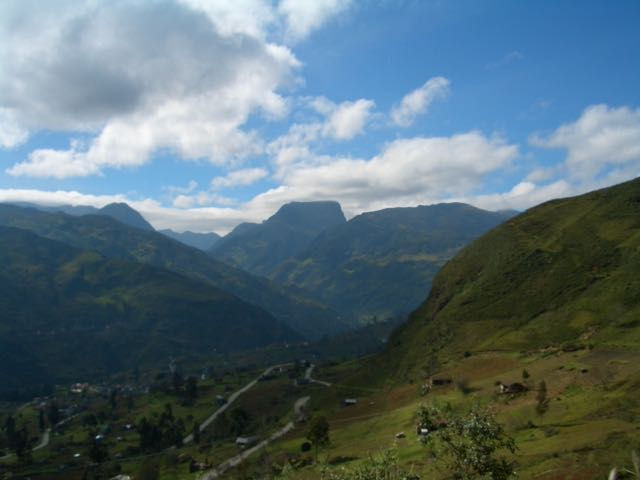
In 2005 my husband took our son, Chas, on a father-son pilgrimage to Ecuador for his high school graduation gift that included searching for lost Inca treasure and visiting Miguel's village. During that trip, Chas was able to witness how much Charles and Miguel meant to each other. In December 2022, our daughter Bronwyn was present for the inauguration of a museum dedicated to Miguel's life and work. We came full circle with Miguel and our lives are better for it. In this blog I'll share our four stories.
Charles's Story
During his post grad trip through Columbia, Ecuador, Peru and Bolivia, Charles purchased some pre-Columbian textile fabric scraps. He was fascinated by the intricate, museum quality design work of early civilizations over two thousand years of ancient Peruvian history. The museums of Lima held vast collections of gold, pottery, and textiles and thus afforded opportunity to learn about the cultures and exceptional design work of the Chancay, Nazca, Paracas and Inca peoples dating from 500 BC to 1530 AD.
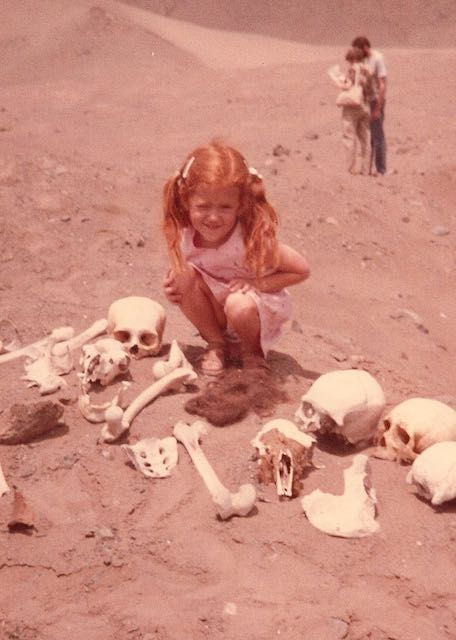
New sites were continuously uncovered in deserts and jungles of Peru by teams of archeologists and documented in National Geographic, further enhancing Charles's curiosity and knowledge about the ancient civilizations of Peru. Unfortunately, grave looters often worked faster than archeologists and thus many of Peruvian artifacts were sold globally to museums and private collectors. Fragments left behind in the desert sand held little value for museums or art markets, but provided incredible opportunity to study the design patterns and techniques. (Note: in later years Bronwyn's favorite activity was to look for pottery shards in the Peruvian desert.)
After traveling for a year, Charles joined the Peace Corps in Ecuador in 1973 and was posted to Cuenca, Ecuador, where he worked with community health promoters. In his spare time, he continued to study the Peruvian textile fragments. On a return trip home, he showed some of his woven remnants to weavers in the Durham and Chapel Hill area. They were enthusiastic and encouraged him to share these textile design samples with artisans in the U.S. as study collections.

Back in Ecuador, Charles went to visit Peace Corps volunteers working in Otavalo. Otavalo is known for weaving and tourists flock to a large open-air market to buy the loom-made ponchos and bags as souvenirs. It's a colorful experience, in both the textiles and the traditional dress of the Otavalians. Men wear white thickly woven cotton pants, woven ponchos and black felt bowler hats. Women wear dark woolen skirts, a matching woven wrap, white blouses and layers of gold-colored beads.

Charles told his friends that his interest was in much finer textiles than those in the market. In response, they introduced him to Miguel Andrango, who made traditional weavings using the backstrap loom in his village of Agato, located beneath the heart of the Imbabura Volcano.
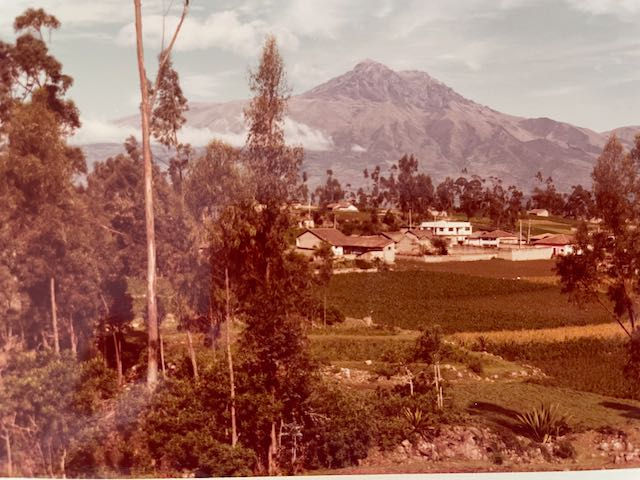
Miguel talked to Charles about his commitment to retain his cultural traditions and his struggles to make a living using this slow and painstaking process. Miguel explained that it took five times the amount of time for him to weave a fabric using the back-strap loom than the majority of Otavalian weavers who used a Spanish loom. Miguel formed a cooperative of weavers in his village who also wove in the traditional manner. When they set out their wares at the market, tourists would say, "I like yours better but I can buy five handwoven textiles for the price of one of yours."

Charles and Miguel did some brainstorming to find a solution. They talked about finding other markets for the textiles and other things Miguel could do with the cooperative such as teaching American weavers how to use the back-strap techniques to replicate these beautiful designs. The idea simmered on the back burner for another year.
After Charles left Peace Corps in 1975 he volunteered for a year to help build a hospital in Sorata, Bolivia, and to train community health workers similar to his work in Peace Corps Ecuador. After completing this work, he returned to Quito to finish off a public health project with the Panamerican Health Organization that he had been working on during Peace Corps years. While there, he went out to visit Miguel and the Tiahuantinsuyo cooperative in Otavala and they talked further about marketing Miguel's textiles.
Charles returned to the U.S. to study Public Health, focusing on international work. Before leaving South America, he returned to Peru and purchased more small textile fragments to sell in the U.S. for school expenses. He traveled around the U.S. and met with university textile departments, giving talks on the art of ancient Peruvian cultures and selling the textiles. Simultaneously he was building contacts for his venture to help Miguel market his skills to weavers in the U.S.

In 1977 Charles helped Miguel obtain a Fulbright travel grant to come to the United States. Miguel brought bundles of textiles and Charles drove Miguel around the U.S. to demonstrate his weaving skills and to sell Miguel's textiles. In 1978, Miguel came again, along with a fellow weaver, Jose. They filled the cargo area of the plane and subsequently our small cottage with bundles of textiles to sell. Neither spoke English so Charles was the translator and chauffeur. Again, they headed out in Charles's rattle-trap Volkswagen van, gave the Miguel and Jose shows, fixed the van (repeatedly) and barely made it home in time for our wedding on July 1, 1978.
Charles took Miguel and Jose to the Raleigh-Durham airport and raced to our wedding rehearsal dinner. One of our dearest friends, Catherine Ryan, made a tiny sculptured rabbit in porcelain and gold for our wedding gift, commemorating the memory of Charles's "in the nick of time" arrival for the wedding. It depicted the rabbit from Alice and Wonderland holding a pocket watch, I'm late, I'm late, for a very important date. Such is life when you marry someone who is a champion of important causes.

The next summer, Charles and Miguel set up a weaving school in a hacienda in Otavalo, and marketed it to U.S weavers. Over the next three years, they ran several fully booked sessions. Some of these weavers then invited Miguel to visit their weaving guilds and art departments in the U.S. with a permanent location in New Mexico. Once Charles's labors paid off, he turned the school over to a tour group in California who continued the program for several years, making Tiahuantinsuyo Cooperative's dreams a reality.

In photo above, Luz Maria as a teen is standing next to Charles (who she remembers as the big man with beard) who is flirting with one of the weavers. Josephina is seated Just to the left of Luz Maria.
My Story

I went on my first overseas trip in December 1976 during holiday break from teaching my multi-grade K-2 classroom. Charles and I had been dating since July and this was going to be the big test for our relationship, on various levels. He had flown ahead to Peru to purchase textiles and then planned to meet me in Quito, Ecuador.
In those days, it required switching planes several times to get to Peru or Ecuador. My first terrifying experience occurred in flight on the Braniff Airlines jet. During the night, the plane was caught in a severe thunderstorm, rocking the plane, with claps of thunder and lightning bolts outside the window. I was sure that I would die. This was about the time of the crash in South America for which the movie "Alive" was based. You get the picture.
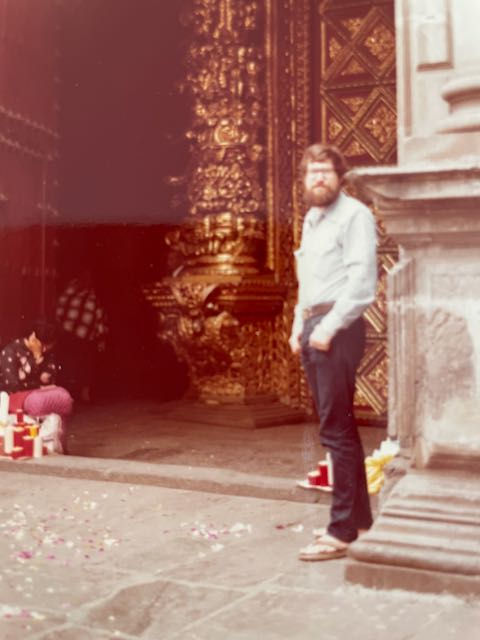
Rattled, but still breathing, I landed in Ecuador and Charles met me at the airport. Good sign. He showed me around the beautiful colonial city where we spent a night or two, upgrading his hotels from 50 cents to a dollar, keeping my comfort in mind. He took me to his favorite restaurant, Leaves of Grass, operated by an American hippie couple. The husband spent his days in the café dining area chewing fat with travelers while his wife slaved away in the kitchen. I could see the glimmer in Charles's eyes that this, to him, was an ideal life. A bad sign.

A parrot told my fortune. The adventure appeared promising.


Then we took a bus down to the Valley of Otavalo. He knew I would enjoy the crafts market and he was eager for me to meet Miguel, and his wife, Josephina. Miguel's village of Agato was outside of Otavalo and we took a small van crowded with indigenous Ecuadorians to reach his house. In those days there was no way to communicate with people other than by letter, so our visit was a surprise to them. In spite of the surprise visit, we were welcomed with great hugs and joy.

We settled in for a few days to visit and discuss the weaving school. The house was a two-story adobe structure, the upstairs providing sleeping mats and storage for piles of woven textiles, which were much appreciated in the cold Andean night air.

In the daytime I warmed myself in the sun and sketched while Charles made some frames and Miguel wove.
I also enjoyed watching Miguel and his neighbors produce household crafts – coiled pots, ropes, and woven mats from sisal, and finely woven "Panama hats" that are and always have been made in Ecuador, not Panama. In the afternoons we enjoyed crispy fried corn kernels and beer, sometimes games ensued.

We washed up from buckets of icy cold water. There was an outhouse and a make-shift shower for those tolerant of glacial temperatures. We washed our jeans by hand, wrung them out, and laid them out to dry. Washing our clothes reminded Charles of a story. Everything reminds Charles of a story.

When he was a volunteer in Sorato, Bolivia, he washed his own clothes in the river until a local woman scolded him for taking jobs away from locals. So he offered her the job of washing his clothes. She asked whether he wanted the job with or without soap, soap costing extra. He paid for the soap, but one day he happened to pass her washing his jeans and noted that she used a rock, not soap to pound out the dirt. He scolded her for cheating him but she scolded him back for being cheap.
Sometime later in the day, after Charles's story, our jeans were dry and stiff, increasing my appreciation for washing machines, dryers and softeners, but also for Charles's storytelling gifts. All this time I was wondering how the Otavalian men kept their white linen pants looking so spiffy when Charles and I were struggling to keep jeans clean in a totally dirt environment, neither pavement nor grass.

Every day I pitched in to help Josephina cook our quinoa, potato and corn soup in a large iron pot over an open fire. The door, when opened, provided light, and there was a board nailed across the bottom of the doorway to keep in several dozen long-haired, guinea pigs (cuy) that ran freely around the dirt floor eating the scraps of potato and vegetable peels thrown at them. I keep a photo in my Beaufort kitchen showing me stirring Josephina's pot in the midst of a swarm of guinea pigs and will add it to this blog when removed from storage after our upcoming move.
Adding to our meal, Miguel, butchered and grilled several of the little long-haired darlings. I was horrified, but declared them delicious. I was young and in love, fascinated by a world I didn't know existed, and determined to impress Charles that my adventurous spirit matched his. It was a bit of a stretch but I survived. I must add that Miguel was equally horrified to see guinea pigs sold for high prices as pets in American pet stores when he came to the U.S. two years later. He kept talking about it. Simply could not believe that guinea pigs were kept as pets, not food. Culture shock.

What I remember and cherish most about that trip is being warmly welcomed into the home of an indigenous family who shared their food, sleeping mats and stories. I realized the difference in typical foreign travel to tourist sites, compared to my mochilero's where you stay in the homes of local people who may be poor in a monetary sense but rich in pride of tradition and moral compass. Miguel and Josephina became my memory postcard of lovely Ecuador and my admiration for the country is linked to the way they welcomed and helped me to know it.
Miguel and Josephina, also served as a guidepost for how we should come to know the six countries where we were posted over the next 25 years. By developing friendships with local people at all walks of life, our work and life were enriched.
Off the track of my Miguel story, I have to add a sidebar about how the rest of my first overseas trip went, ending with me telling Charles I never wanted to see him again as long as I lived. I have mentioned this in a previous blog but this story provides the context.
From Ecuador we went to Lima, Peru, where we met another of Charles's close friends, Aurelio Santander. Along with fishermen on the docks, we ate Peru's famous dish- spicy and limey ceviche served traditionally with corn on the cob and sweet potato to cool down the spice. From there we flew to La Paz, Boliva, the highest capital city in the world. Charles warned me that I would feel like I was attacked with the worst flu virus in my life, but it was only altitude sickness. He wanted me to taste the best breakfast in the world, saltenas, and to travel with him to the valley of Sorata where he had worked and nearly died with hepatitis.
We placed our backpacks on the Sorata bus and stepped out to the corner to grab a bite to eat. In what seemed liked three minutes and three yards from the bus, our backpacks were stolen requiring a miracle to acquire new passports on Christmas Eve. Thankfully, Charles had a friend in the Embassy. With passports in hand but no visa stamps we took a two-day trip across the altiplano heading for Peru in the back of a cattle truck filled to standing with people.
When we reached the border, the fat guard in a dirty white undershirt was shocked to see that we had no visa stamp to enter Bolivia and he could therefore not provide one for exit. Disgusted at our request, he stormed into a back room and slammed the door, probably to finish his nap. Charles looked down at the visa officer's desk, about to pick up the visa stamp when I warned him that if the guy walked out at that moment we would end up in Bolivian prison. Remember, no cell phones, no calling home or to your Embassy for help.
We stood around outside for a while and then Charles said he had an idea so we crossed the footbridge over a creek marking the border and came to the entry visa shed for Peru. From outside we heard the border patrol screaming at a couple of travelers due to some infraction. We took a big breath and went in all friendly talking about the weather and how great it was to be back in Peru. The border officer responded in equally friendly terms until he gasped at our blank passports with no Bolivian or Peruvian visas nor did we have the necessary airline ticket showing we had the required scheduled flight out. He then told us to get lost, but Charles stood his ground and told him the whole, long story. The guy still didn't budge until Charles told him that he knew that the Peruvians would be much more sensible than those awful Bolivians. The guard said, "Hell yes!!!!" and stamped our entry into the country.
On the interim night between La Paz and Peru, the cattle truck stopped and the local passengers quickly dispersed leaving us in a pitch black village with barking dogs to look for a hostel to sleep. My face was sunburned and I had scabs along the part of my hair from the Andean sun by the next day when we arrived in a dreadful little town called Puno, Peru (which coincidentally would become our first overseas post four years later, a place now filled with fondest of memories.) But not that day.
Puno is situated on the banks of Lake Titicaca and we went out to visit Taquile island, famous for the women's traditional weaving and men's hand- knitted intricate caps using bicycle spokes for needles. A fond memory on our boat trip out was a German woman knitting a scarf sitting alongside a Taquile man knitting a far finer cap.
About this time, Charles broke the news to me that he would like for me to travel back to the U.S, with the slightly illegal textile fragments that he had purchased in Peru, hidden among my clothing in my backpack. His thoughts: What border guard would suspect a sweet little early childhood teacher of anything shady? I refused and it was there we parted on the worst of terms.
So, forgive the side story to Bolivian and Peruvian Andes, and close it with the thought that Miguel and Josephina were the best part of the trip.
Chas's Story
This part will be to the best of my recollection, since Chas has not answered pleas to suggest edits. He has been too busy building animatronic creatures in Asheville; or helping his partner, Katerina Don, trouble shoot some of the animation and computer software issues with her on-line education program, Cholpori, in Bangladesh; or hanging out with Faiyaz, his oldest and best friend from middle and high school who is now an architect who jet-sets between Toronto and Dhaka; or giving actress Tilda Swinton an insider's tour of Old Dhaka. I guess this verifies that my kids live lives of forward action, while I indulge in memory, which is subjective, and they are too busy or polite to correct. So here goes the story.

Throughout Chas's childhood, Charles tantalized the child with his Andean adventure stories, which generally included mishaps. In a former blog on Fatherhood, I wrote about Charles and asked Chas to share some memories. Chas wrote that his dad and he share a love and talent for misadventure.
The story Chas loved best was the one about the haunted mountain in Ecuador on which locals believed held one of the lost Inca treasures. After capturing Atahualpa, Pizarro sent word throughout the Inca Empire that he would release Altahualpa once his people filled several designated rooms with gold statues and ornaments. After amassing much gold, but much more still in route from outlying realms of the Inca Empire, Pizarro broke his word and killed Atahualpa. Word spread and many carts of gold in route to Lima were dumped into lakes high in the Andes. When an Andean refers to a sacred lake they mean it was one where sacrifices were made, both human and gold.
Charles told Chas that he had the opportunity to join an expedition of mountain climbers who had studied the area and believed the treasure to be located on a mountain with a sacred lake and a reputation that anyone who attempted to retrieve the treasures would die. This group of mountaineers had already made a first attempt with many ominous occurrences that made them turn back. Charles joined them on their second attempt but it too failed. (If you want to know the full story ask Charles.)
Charles promised Chas that they would return to Ecuador and search for the gold. This got Chas through high school with his sights set on an Ecuadorian adventure in the summer of 2005. What occurred is a long and tangled tale, yes full of mishaps, for which they climbed a mountain without their gear (having been stolen) wearing flimsy market garments with little protection against the cold and freezing rain.
What Chas equally remembers about that trip is their visit to Otavalo to see Miguel. His home was difficult to locate with so many changes having taken place since we took Chas and Bronwyn to meet Miguel in 1993 when our children were ages six and eleven. Miguel recognized Charles immediately and pleased to see 18-year-old Chas. He ushered Charles and Chas into the house. After a while, don Miguel got up and excused himself.

Miguel returned with a plastic bag, covered in dust, saying he knew Charles would return some day and was saving this for him. Chas remembers his father gasping at the contents – a beautiful double weave Otavalian poncho. The Washington Textile Museum had commissioned one of these ponchos for their collection. The one being handed to Charles might be the last one.
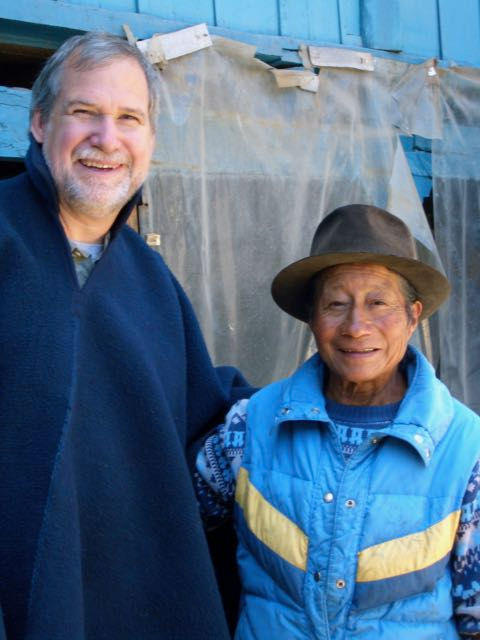
Chas realized how much Miguel valued his friendship with Charles and the way he had chosen to thank Charles for his selfless, voluntary work on the weaving school over three years. Charles had refused to take any payment for organizing and managing the school from 1979 – 1981 and told Miguel that the only thing he wanted was one of Miguel's double woven ponchos. This conversation took place twenty-six years prior to the visit with Chas and Charles and thus a bit of a shock that Miguel took the agreement so seriously and saved the poncho over so many years. Charles told Chas that Miguel was the last Otavalian Indian to make the double-woven ponchos, folowing a tradition that dates back to pre-colonial days, further impressing Chas with the importance of this gift.
Miguel helped Chas learn important things about his father and cross-cultural friendship.
Bronwyn's Story

In September 2022, USAID sent our daughter, Bronwyn, an environmental officer, to provide assistance to USAID Ecuador for three months. She took full advantage of the outdoor activities on weekends - hiking and biking, and diving with the cool critters in the Galapagos- which also related to her work, protecting Ecuador's natural assets.
Shortly after arrival, she noted that two of Miguel's textiles are formally hung in the U.S. Embassy, one in a corridor and the other in a conference room. Bronwyn was excited to see that others, besides our family, recognized Miguel as a skilled textile designer and weaver.
Bronwyn planned a weekend trip with friends in November to go to Otavalo and visit Miguel and his studio. Sadly, she learned that Miguel had passed away six months prior and the shop was run by his daughter Luz Maria who had been a young child when Charles and I first visited. Luz Maria remembered Charles as the man with the big beard. We have photos of her as a wee child and later as a teen girl in indigenous dress at the weaving school with an American weaver and the big, bearded man.

Bronwyn enjoyed reminiscing with Luz Maria and meeting her husband Rafael, who is a weaver, and her son and grandsons who weave after school. We have photos of Miguel teaching one of his grandsons to weave during the time Charles ran the weaving school. Bronwyn learned that Josephina died a couple years ago. Luz Maria told Bronwyn that they were in the process of establishing a museum to honor Miguel and showcase his work over the years, and it would be housed in Miguel and Josephina's house in Agato.
In December, Luz Maria and her cooperative of family weavers came to the American Embassy for a holiday craft fair. At that time, Luz Maria invited Bronwyn to attend the opening of the Miguel Andrango Museum the week before Bronwyn's return to the U.S.

Bronwyn described it as an emotional experience to have known Miguel as a child, always aware of the important friendship between Miguel and her father, and to be there to say good-bye for her father. She enjoyed looking at the display of weavings and the personal albums of photos and mementos. To her delight, Bronwyn found old photos of her parents bringing to life the stories she had heard throughout her life.
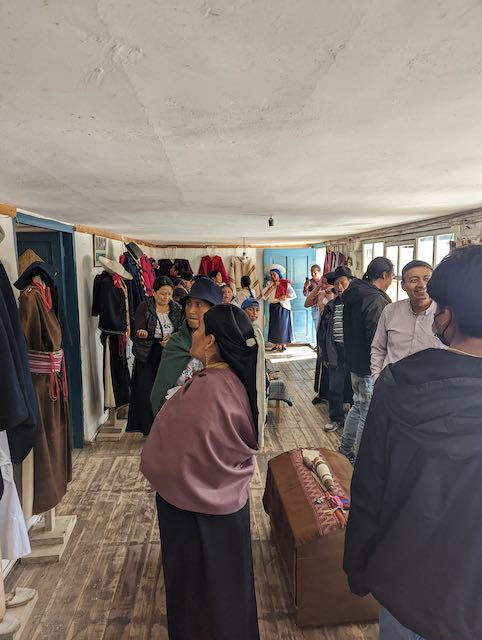


Miguel's last weaving, incomplete and still on the loom with weaving shuttles and design sticks that Miguel used his entire life, is displayed in the museum.
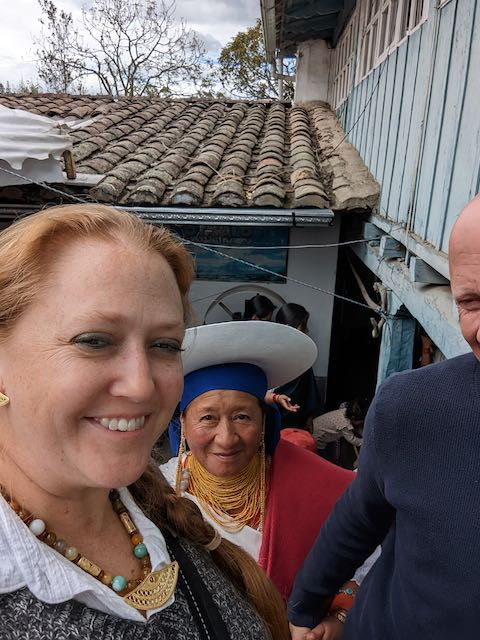
Bronwyn told Luz Maria that we will put together an album from our family photos, many in this blog, to send to the museum. Bronwyn also told her that Charles would like to donate his poncho from Miguel to the museum if they do not have another example of this complicated double-weave technique.
Before the ribbon cutting, Bronwyn was invited to speak about our shared family history with Miguel. The festivities continued with dancing, eating quinoa soup and cuy, and drinking chicha, a trademark of all Otavalian parties.
Some of Bronwyn's photos and a video of the day are included here. You can also visit the website: MiguelAndrango.weebly.com
From the Andrango family collection of weavings for sale, Bronwyn bought a textile for Charles woven by Miguel's son and a modern textile for herself, much like this one in the gallery.


Closing Thoughts
Posthumously, Miguel Andrango has been recognized as a National Treasure of Ecuador. Charles, Bronwyn, Chas and I feel proud to have known such a great man and his wife, Josephina, who was quite the businesswoman behind his successful enterprise, always layered in traditional beads and a smile. How absolutely wonderful that our daughter was present for the inauguration of a museum dedicated to Miguel's life and work.
In 1975, Charles recognized Miguel's artistic gift and honored his conviction to preserve a cultural tradition by helping him promote his talents on an international stage. Charles worked hard to help Miguel obtain the notoriety he deserved and for that we feel proud and connected. Miguel's family story is also part of our own.
























































Deborah, this is such a fabulous account of your adventures. I am so pleased that today I found your card, misplaced among my books during our stay in Beaufort. You gave me your card at the end of dinner at Gerda and Lee’s in early July. We were staying in town for two weeks at the Talbots home down the street. It is a pleasure to read your blog! As you have spent time in Peru, I thought you might enjoy knowing about an exhibit that opened yesterday here in Winston-Salem at the Southeastern Center for Contemporary Art (SECCA, now part of NC Museum of Art). Called Corpus, the show features the ceramic sculptural work of Peruvian-American artist Kukuli Velarde.…